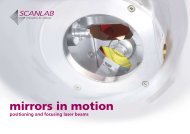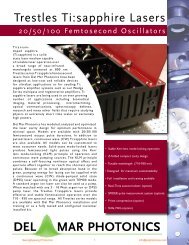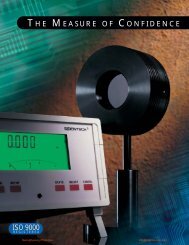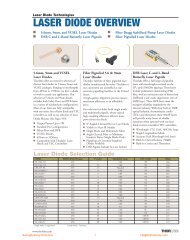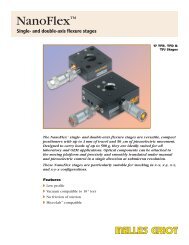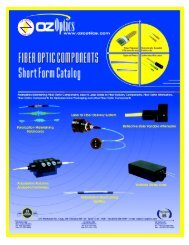SAM – saturable absorber mirror
SAM – saturable absorber mirror
SAM – saturable absorber mirror
- No tags were found...
You also want an ePaper? Increase the reach of your titles
YUMPU automatically turns print PDFs into web optimized ePapers that Google loves.
Non-<strong>saturable</strong> losses are caused by the transmission and the absorption of the Bragg<strong>mirror</strong>. The absorption of the thin film stack can be very low (< 0.1 %). The transmissionloss of the Bragg <strong>mirror</strong> decreases with increasing number of the high and low index filmpairs. The transmission loss of an AlAs/GaAs multilayer stack of 25 film pairs at the designwavelength is < 0.1 %.Beside this the high reflection band width and the group delay dispersion of the <strong>mirror</strong> hasto be taken into account, especially in the case of ultra short pulses.The sum of the non-<strong>saturable</strong> losses can be described by a value A ns , which is typical < 0.3% at the design wavelength.> 5. Relaxation timeThe <strong>saturable</strong> <strong>absorber</strong> layer consists of a semiconductor material with a direct band gapslightly lower than the photon energy. During the absorption electron-hole pairs are createdin the film. The relaxation time τ of the carriers has to be a little bit longer than the pulseduration. In this case the back side of the pulse is still free of absorption, but during thehole period between two consecutive pulses the <strong>absorber</strong> is non saturated and prevents Q-switched mode-locking of the laser.Because the relaxation time due to the spontaneous photon emission in a directsemiconductor is about 1 ns, some precautions has to be done to shorten it drastically.Two technologies are used to introduce lattice defects in the <strong>absorber</strong> layer for fast nonradiativerelaxation of the carriers:●●low-temperature molecular beam epitaxy (LT-MBE)ion implantation.The parameters to adjust the relaxation time in both technologies are the growthtemperature in case of LT-MBE and the ion dose in case of implantation.Typical values of the relaxation time τ of <strong>SAM</strong>s are between 0.3 and 2 ps.> 6. Saturation fluenceThe saturation process can be better quantified by the pulse fluence Φ than by the intensityI because of the limited relaxation time τ. To minimise the losses, the <strong>absorber</strong> should be<strong>saturable</strong> with the expected pulse fluence Φ, e.g. the pulse energy in the laser should beseveral times more than the saturation energy, but not too high because then the lasertends to exhibit multiple pulsing. An other limitation is the damage threshold of the <strong>SAM</strong>.A typical saturation fluence Φ sat is about 70 µJ/cm 2 .In the laser cavity the incident pulse fluence Φ can be adjusted by varying the illuminatedarea a on the <strong>SAM</strong>. If the intracavity pulse power is low, e.g. because of low pump power,then tighter focussing helps to achieve the necessary saturation fluence Φ sat of typicallysome ten µJ/cm 2 .In analogy to eq. (1) the (<strong>saturable</strong>) absorption A of the <strong>SAM</strong> can be calculated bySeongKyeong Photonics 9 info@skphotonics.com




